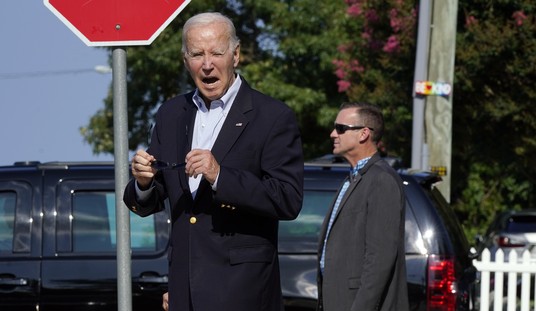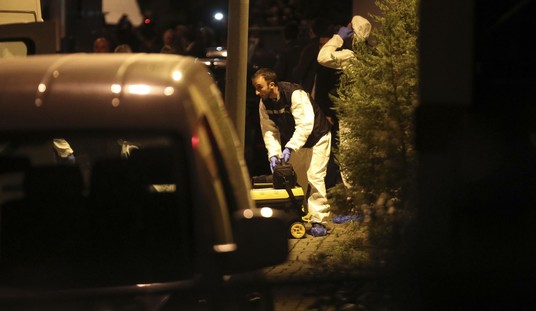
Peace Cross Memorial. Governor Hogan Tours Department Of Legislative Services by Scott Henderson at Peace Cross, Bladensburg, Maryland by Maryland GovPics, licensed under CC BY-SA 2.0/Original
For nearly 95 years a 40-foot tall Latin cross has stood on public land in Bladensburg, MD, to commemorate US war dead in World War I. For most of that time the cross was uncontroversial, but then in 2014 a group of liberal atheist scolds operating under the guise of the “American Humanist Association” filed a lawsuit demanding that the monument be demolished because it gave them the heebie-jeebies every time they looked at it and because this cross on public land meant that Christianity was established as the official religion of the United States. A federal district court heard the case and granted summary judgment against the scolds, but the Fourth Circuit not only threw out the judgment, it ruled that the cross was unconstitutional and sent the case back to the lower court for a decision on what to do next…presumably something involving bulldozers. Today the Supreme Court issued a 7-2 ruling, Alito writing the majority opinion and Sotomayor and Ginsburg dissenting, which said, in essence, “yeah, its a Christian symbol and get over it.”
The opinion was interesting because the reasoning that Alito took, and which brought a solid majority along with him, basically ignored the historic Lemon test for determining if a religious symbol was too hurtful to be displayed on public grounds. That test sets the bar at the practice or object serving a secular purpose, its principal effect does not advance or inhibit religion, and it does not create an “excessive entanglement with religion.”
Via SCOTUS Blog:
Justice Samuel Alito wrote for the court today, in an opinion that once again eschewed the use of the Lemon test. Alito began by explaining that although the cross “came into widespread use as a symbol of Christianity” and continues to have that meaning today, it “has also taken on a secular meaning” in other contexts. In particular, Alito noted, the cross became a “central symbol” of World War I – which likely explains the choice to use a massive cross as the memorial for the Prince George’s County soldiers.
Alito then reasoned that in cases involving longstanding religious memorials or symbols, the Lemon test should not apply. At least when the question is whether to keep them in place, rather than to put up new ones, Alito emphasized, there should be a presumption that they are constitutional.
That presumption, Alito continued, applies here: Not only did the cross start off with the “added secular meaning” associated with World War I, but it took on “historical importance”: It reminds local residents of the conflict and the sacrifices that area soldiers made. On the other hand, there is no evidence that Jewish soldiers were either “deliberately left off the list on the memorial” or “included on the Cross against the wishes of their families.”
“The cross is a Christian symbol,” Alito concluded, “but that fact should not blind us to everything else that the Bladensburg Cross has come to represent. For some, that monument is a symbolic resting place for ancestors who never returned home,” while for others “it is a place for the community to gather and honor all veterans and their sacrifices for our Nation.” “For many of these people,” Alito stressed, “destroying or defacing the Cross that has stood undisturbed for nearly a century would not be neutral and would not further the ideals of respect and tolerance embodied in the First Amendment.”
Justice Clarence Thomas also would have allowed the cross to stand, but for a different reason: He believes that the Constitution’s establishment clause does not apply to the states at all. Even if it did apply to the states, he added, there would still not be any constitutional violation – either because the establishment clause only applies to laws passed by a legislature or because the clause requires actual coercion by the government.
Justice Neil Gorsuch also agreed that the cross should be permitted to remain in place, but he argued that the case should be dismissed, because the challengers do not have a legal right, known as “standing,” to bring a lawsuit. Simply being offended by the cross’s presence is not, Gorsuch contended, enough to justify the lawsuit.
2. "As time goes by, the purposes associated with an established monument, symbol, or practice often multiply." Passage of time may obscure original religious purpose and make monument historically/culturally significant.
— Ed Whelan (@EdWhelanEPPC) June 20, 2019
4. Removing a longtime monument might seem aggressively hostile to religion, reminiscent of "militantly secular regimes."
Note that Breyer and Kagan were part of majority on this Part II-B.
— Ed Whelan (@EdWhelanEPPC) June 20, 2019
"Retaining established, religiously expressive monuments, symbols, and practices is quite different from erecting or adopting new ones. The passage of time gives rise to a strong presumption of constitutionality." SCOTUS in #PeaceCross.
— Ed. Condon (@canonlawyered) June 20, 2019
"A government that roams the land, tearing down monuments with religious symbolism and scrubbing away any reference to the divine will strike many as aggressively hostile to religion." SCOTUS in Peace Cross decision.
— Ed. Condon (@canonlawyered) June 20, 2019
And predictably, the legal big brains on the left went full bore theocracy:
The majority opinion does real damage to the Establishment Clause—which is why Ginsburg is reading her dissent from the bench. It doesn't officially kill off the Lemon test, but it does strictly limit its application. Bad news for church-state separation. https://t.co/Y2G1oiUUSI
— Mark Joseph Stern (@mjs_DC) June 20, 2019
On the one hand, the decision did what was needed. It kicked this bunch of anti-religious scolds to the curb and told them to get a life and it did it in a way that will make the lawfare being conducted against religion to continue. On the other hand, it left in place an, in my view, unconstitutional prejudice against Christian symbols and references in the public square…because let’s face it, we live in a society where the prohibition on an establishment of religion is regularly employed to suppress Christian imagery and yet school children can be required to recite the Muslim shahada in order to pass a high school history class. The court should have jettisoned the whole mess and simply stated that unless a government was forcing people to profess a particular faith in order to receive services or to hold office, that religious symbols were, by definition, not establishing religion.
=========
=========
Like what you see? Then visit my story archive.
Follow @streiffredstate
I’m on Facebook. Drop by and join the fun there.
=========
=========













Join the conversation as a VIP Member